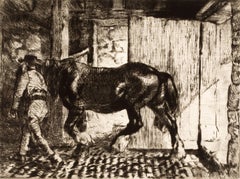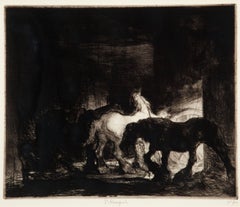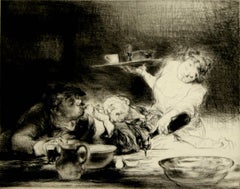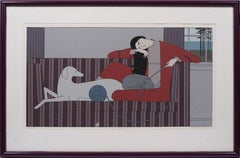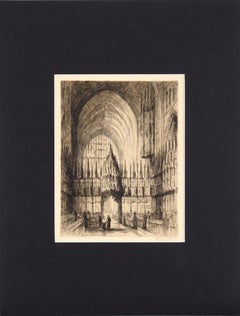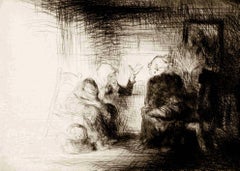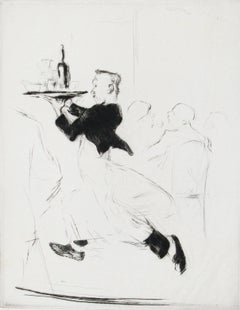Drypoint Interior Prints
to
4
2
3
Overall Width
to
Overall Height
to
6
6
3
2
2
2
6
2
1
3
2
5
3
3
3
2
1
1
1
1
1
6
6
5
6
Artist: Edmund Blampied
Medium: Drypoint
Returning to the Stable.
Located in Storrs, CT
Returning to the Stable. 1920. Drypoint. Appleby 64. 8 3/4 x 12 1/4 (sheet 11 7/16 x 16 1/8). Edition 100. A rich impression printed on cream laid paper wi...
Category
1920s Modern Drypoint Interior Prints
Materials
Drypoint, Etching
$800 Sale Price
36% Off
Night Time in a Stable.
Located in Storrs, CT
Night Time in a Stable. 1927-28. Drypoint. Appleby 131. 10 1/8 x 12 1/8 (sheet 11 1/2 x 16 1/2). Edition 100. Illustrated: Print Collector's Quarterly 25 (1...
Category
Early 20th Century Modern Drypoint Interior Prints
Materials
Drypoint, Etching
Vin Rouge (Red Wine)
Located in Storrs, CT
1932. Drypoint. Appleby 167. 9 1/4 x 11 5/8 (sheet 11 3/8 x 17 15/16). Edition 100 #48. Mat line, well outside the image; otherwise excellent condition. A rich impression with drypo...
Category
1930s Modern Drypoint Interior Prints
Materials
Drypoint
$1,750 Sale Price
30% Off
Politics
Located in Storrs, CT
Politics (Tonnere de Brest). 1926. Drypoint. Appleby 108. 7 x 9 (sheet 10 1/2 x 15 1/2). A rich impression printed on cream wove paper with full margins. Illustrated: Salaman, Modern...
Category
Early 20th Century Modern Drypoint Interior Prints
Materials
Drypoint, Etching
$1,250 Sale Price
28% Off
The Letter
Located in Storrs, CT
The Letter. 1921. Drypoint. Appleby 107. 7 x 9 3/8 (sheet 10 1/2 x 15 7/16). Edition 100. Illustrated: Fine Prints of the Year, 1925; Salaman, Modern Masters of Etching: Edmund Blamp...
Category
Early 20th Century Modern Drypoint Interior Prints
Materials
Drypoint, Etching
$1,250 Sale Price
28% Off
Soup
Located in Storrs, CT
Soup. 1920. Drypoint. Appleby 65. 9 x 8 1/8 (sheet 15 x 11 9/16). Edition 100. Illlustrated: Print Collector's Quarterly 13 (1926): 85. Signed in pencil.
Edmund Blampied was a painter, etcher, lithographer and sculptor. Born in 1886 to a family of three boys in St. Martin, Jersey, Blampied became interested in drawing at an early age. After visiting the studio of John Helier Lander in 1899, Blampied decided to make a career as an artist. In 1903 he went to London to attend Lambeth Art School, where he studied etching under Walter Seymour.
In 1905, he joined the Daily Chronicle as an artist. In that year he was awarded a scholarship to Bolt Court Scool of Photo-engraving and Lithography.
In 1912 he left the Chronicle and established his own studio. He earned a living by illustrating novels and short stories.
In 1913, he had his first exhibition at the Leicester Gallery in London. The following year he married Marianne Van Abbé.
During the 1920's, he became a member of the Royal Society of Painter-Etchers and Engravers. During the 1920s Blampied became a member of the Royal Society of Painters-Etchers and Engravers and exhibited in London to critical acclaim. He produced a folio of comic drawings in the 1930s which was published in New York in 1934 and another that was published in London in 1936. The Keeper of Prints and Drawings at the British Museum published a mongraph on his work. His London exhibitions were highly successful.
In 1938, he moved to Bulwarks, St.Aubin in Jersey, but at the onset of the Occupation, had to relocate to Route Orange, St. Brelade. remained there throughout World War II during the German Occupation, despite the fact that his wife was Jewish. During the Occupation he designed bank...
Category
1920s Modern Drypoint Interior Prints
Materials
Drypoint, Etching
Related Items
Antique American Modernist Portrait Signed Limited Edition Serigraph Interlude
By Will Barnet
Located in Buffalo, NY
Vintage American modernist interior scene by Will Barnet. Titled "Interlude". Signed and numbered limited edition from 1982.
Category
1980s Modern Drypoint Interior Prints
Materials
Screen
$1,580 Sale Price
20% Off
H 32 in W 49 in D 2 in
Chester Cathedral - Drypoint Etching in Ink on Paper
Located in Soquel, CA
Chester Cathedral - Drypoint Etching in Ink on Paper
Dramatic drypoint etching by J. Alphege Brewer (British, 1881-1946). This composition shows the interior of Chester Cathedral in Brewer's characteristic style - highly detailed and with strong contrast. The scene encompasses the cathedral from floor to ceiling, capturing the immense size of the building. There are several people in the scene which contribute to the sense of scale.
Signed by hand "J. Alphege Brewer" in the lower right corner.
Titled "Chester Cathedral" in plate, lower left corner.
Includes original card with artist's name.
Presented in a new black mat with foamcore backing.
Mat size: 16"H x 12"W
Paper size: 10.75"H x 7.75"W
James Alphege Brewer was well known in the early 20th century as a producer of color etchings of European cathedrals and other scenes of church, college, and community. He was born July 24, 1881, in the Kensington section of London, England, the son of Henry W. Brewer, noted artist of historical architecture and prominent convert to the Catholic Church, and the grandson of John Sherren Brewer, Jr., “the brilliant editor of the Calendar of Letters of Henry VIII.” His great uncle was E. Cobham Brewer, the polymath who compiled Brewer’s Dictionary of Phrase and Fable. Among his older siblings were the artist Henry C. Brewer and the organist and writer John Francis Brewer.
Brewer attended the Westminster School of Art in London, where his brother Henry also trained. In 1910, he married Florence Emma Lucas, an accomplished painter in oil and watercolor, whose father was the noted landscape artist George Lucas and whose great uncle was David Lucas, the famous engraver for John Constable. Florence's brothers Edwin and George assisted Brewer in the printing of Brewer's etchings.
Brewer exhibited at the Royal Academy (RA) and the Royal Institute of Painters in Watercolour (RI), at the Paris Salon of the Académie des Beaux-Arts, and in the shows of the Royal Cambrian Academy (RCA). He became an associate of the Royal Cambrian Academy in 1929 and a full member in the last two years of his life. He was also a member of the Hampstead Society of Artists, the Society of Graphic Art, and the Ealing Arts Club, where he was first Honorary Art Secretary and then Honorary Art Chairman. Most of Brewer's larger etchings were published by Alfred Bell...
Category
Early 20th Century Romantic Drypoint Interior Prints
Materials
Paper, Ink, Drypoint
$396 Sale Price
20% Off
H 16 in W 12 in D 0.25 in
Tea For Two - Brock
By Harry Bunce
Located in Deddington, GB
Tea for Two – Brock [2017]
limited_edition
Screenprint
Edition number 156
Image size: H:31 cm x W:25 cm
Complete Size of Unframed Work: H:49 cm x W:41 cm x D:0.3cm
Sold Unframed
Ple...
Category
21st Century and Contemporary Drypoint Interior Prints
Materials
Screen
Don Juan
By Louis Icart
Located in Missouri, MO
Aquating Engraving
Image Size: approx. 20 1/4 x 13 3/8
Framed Size: 28 x 20.5 inches
Pencil Signed Lower Right
Louis Justin Laurent Icart was born in Toulouse in 1890 and died in Paris in 1950. He lived in New York City in the 1920s, where he became known for his Art-Deco color etchings of glamourous women.
He was first son of Jean and Elisabeth Icart and was officially named Louis Justin Laurent Icart. The use of his initials L.I. would be sufficient in this household. Therefore, from the moment of his birth he was dubbed 'Helli'. The Icart family lived modestly in a small brick home on rue Traversière-de-la-balance, in the culturally rich Southern French city of Toulouse, which was the home of many prominent writers and artists, the most famous being Henri de Toulouse-Lautrec.
Icart entered the l'Ecole Superieure de Commerce de Toulouse in order to continue his studies for a career in business, particularly banking (his father's profession). However, he soon discovered the play writings of Victor Hugo (1802-1885), which were to change the course of his life. Icart borrowed whatever books he could find by Hugo at the Toulouse library, devouring the tales, rich in both romantic imagery and the dilemmas of the human condition. It was through Icart's love of the theater that he developed a taste for all the arts, though the urge to paint was not as yet as strong for him as the urge to act.
It was not until his move to Paris in 1907 that Icart would concentrate on painting, drawing and the production of countless beautiful etchings, which have served (more than the other mediums) to indelibly preserve his name in twentieth century art history.
Art Deco, a term coined at the 1925 Paris Exposition des Arts Decoratifs, had taken its grip on the Paris of the 1920s. By the late 1920s Icart, working for both publications and major fashion and design studios, had become very successful, both artistically and financially. His etchings reached their height of brilliance in this era of Art Deco, and Icart had become the symbol of the epoch. Yet, although Icart has created for us a picture of Paris and New York life in the 1920s and 1930s, he worked in his own style, derived principally from the study of eighteenth-century French masters such as Jean Antoine Watteau, François Boucher and Jean Honoré Fragonard.
In Icart's drawings, one sees the Impressionists Degas...
Category
1920s Art Deco Drypoint Interior Prints
Materials
Engraving, Aquatint
"King of the Friendly Islands" (Tonga); Engraving from Captain Cook's 3rd Voyage
By John Webber
Located in Alamo, CA
"Poulaho, King of the Friendly Islands, Drinking Kava" is an engraving created by William Sharp (1749-1824), from a drawing by John Webber (1752-1793), who was the artist on Captain James Cook's 3rd and final voyage of discovery. It was published in the atlas of "A Voyage to the Pacific Ocean Undertaken by the Command of His Majesty, for Making Discoveries in the Northern Hemisphere", the official British Admirality sanctioned journal published upon completion of the voyage in London in 1784 by Strahan & Cadell.
Captain Cook visited Tonga on his 3rd voyage, which he named The Friendly Islands because of the warm welcome he and his crew received, unlike some of the other more hostile Pacific islands. The engraving depicts Cook and his men observed a kava ceremony at the village of Mu’a on Tongatapu. King Paulaho sits in the centre foreground, his back to the spectator with a man kneeling before him. The ceremonial mat depicted behind Paulaho indicates that nobody was allowed to sit behind him. The figure in the centre holds a single cup, referring to the Tongan custom of offering the cup to the king first. Kava is native to the islands of the South Pacific and was first described for English readers in 1768 by Captain James Cook. The kava root has been used for centuries as a central feature of ceremonies and celebrations because it was able to bring about a calming and pleasant social atmosphere. The root was crushed and processed into coconut milk to become the focal ceremonial beverage, simply referred to as kava.
This engraving is presented in a Koa wood frame and a white mat. Koa wood is legendary in Hawaii. There are occasional faint spots, but the print is otherwise in very good condition. This amazing Koa wood is native to Hawaii and it is known for the deep rich colors and varied grain pattern. Koa has an honored heritage in Hawaii and is highly revered and sacred. The word “koa” means “warrior” in Hawaiian. The warriors of King Kamehameha the Great, created canoes and weapons from a wood plentiful on the Big Island of Hawaii. This wood became synonymous with the warriors themselves, and it became known as koa.
There are three other engravings listed from the official journal of Captain Cook's 3rd voyage available that are presented in identical Koa wood frames and mats (LU117324682422, LU117324684052, LU117324684032). They would make a wonderful grouping for a display of 2, 3 or 4 prints. A discount is available for a grouping depending on the number of items included.
Captain Cook is remembered as one of the greatest explorers and navigators in history. His explorations included Australia, New Zealand and islands of the South Pacific and the northwest coast of North America. Hawaii was discovered by Captain Cook during this voyage. Hawaii was originally called The Sandwich Islands in honor of The Earl of Sandwich...
Category
1780s Realist Drypoint Interior Prints
Materials
Engraving
$2,375
H 18.25 in W 23.5 in D 0.88 in
Picasso "Toros & Toreros" Photolithography
Located in Cuauhtemoc, Ciudad de México
This framed Picasso print, is an offset lithographic book plate from a captivating book, entitled Toros y Toreros (Bulls and Bullfighters), which ...
Category
Mid-20th Century Cubist Drypoint Interior Prints
Materials
Lithograph
$560 Sale Price
20% Off
H 11.01 in W 14.97 in D 0.1 in
Picasso "Toros & Toreros" Photolithography
Located in Cuauhtemoc, Ciudad de México
This framed Picasso print, is an offset lithographic book plate from a captivating book, entitled Toros y Toreros (Bulls and Bullfighters), which ...
Category
Mid-20th Century Cubist Drypoint Interior Prints
Materials
Lithograph
Picasso "Toros & Toreros" Photolithography
Located in Cuauhtemoc, Ciudad de México
This framed Picasso print, is an offset lithographic book plate from a captivating book, entitled Toros y Toreros (Bulls and Bullfighters), which ...
Category
Mid-20th Century Cubist Drypoint Interior Prints
Materials
Lithograph
$560 Sale Price
20% Off
H 22.44 in W 18.5 in D 0.78 in
Picasso "Toros & Toreros" Photolithography
Located in Cuauhtemoc, Ciudad de México
This framed Picasso print, is an offset lithographic book plate from a captivating book, entitled Toros y Toreros (Bulls and Bullfighters), which ...
Category
Mid-20th Century Cubist Drypoint Interior Prints
Materials
Lithograph
Home David Hockney (Six Fairy Tales from the Brothers Grimm) Clandeboye House
Located in New York, NY
From David Hockney’s celebrated Six Fairy Tales from the Brothers Grimm portfolio, an image from the story of ‘The boy who left home to learn fear’. Hockney chose this story for its ...
Category
1960s Modern Drypoint Interior Prints
Materials
Etching, Aquatint
$9,000
H 24.75 in W 17.75 in
'Jesus and the Woman at the Well, ' by Amand-Durand, Engraving
By Armand Durand
Located in Oklahoma City, OK
This early 19th century framed 35" x 31" engraving by artist Amand-Durand depcits an etching of 'Jesus and the Woman at the Well,' after the Dutch master, Rembrandt van Rijn. This poignant Biblical story is depicted by Arman-Durand in Rembrandt style...
Category
Early 19th Century Old Masters Drypoint Interior Prints
Materials
Engraving
$1,200 Sale Price
20% Off
H 30.5 in W 26.5 in D 1.5 in
William P. Hicks, Circus
Located in New York, NY
William P. Hicks has drawn everything about the circus that will fit in the plate. The main figure is an aerial act with a woman balancing on rope held by a figure on the floor. Ther...
Category
1930s American Modern Drypoint Interior Prints
Materials
Etching
Previously Available Items
Village News
Located in Storrs, CT
Village News. 1930-31. Drypoint. Appleby 148. 8 3/4 x 12 (sheet 11 3/8 x 17 1/8). Edition 100. A rich impression with drypoint burr, printed on the full sheet of cream laid paper wit...
Category
1930s Modern Drypoint Interior Prints
Materials
Drypoint, Etching
Toute de Suite. (Immediately, Right away).
Located in Storrs, CT
Toute de Suite. 1930-31. Drypoint. Appleby 151. 10 1/8 x 8 1/16 (sheet 15 1/2 x 10 3/8). Edition 100, #8. A rich impression, with drypoint burr, printed on cream-colored laid paper w...
Category
1930s Modern Drypoint Interior Prints
Materials
Drypoint, Etching
Les Deux Petites Verres.
Located in Storrs, CT
Les Deux Petite Verres. 1928-29. Drypoint. Appleby 135 10 1/2 x 10 3/16 (sheet 18 1/4 x 12 3/8). Edition 100, #65. Illustrated: Print Collector's Quarterly (1937): 374. A rich impression, with burr, printed on the full sheet of laid paper. Signed and numbered in pencil.
This is a most charming study of a husband and wife sitting in a cafe, about to imbibe. The title is a pun on the glasses and the couple. See Tout de Suite...
Category
1920s Modern Drypoint Interior Prints
Materials
Drypoint, Etching
Drypoint interior prints for sale on 1stDibs.
Find a wide variety of authentic Drypoint interior prints available on 1stDibs. While artists have worked in this medium across a range of time periods, art made with this material during the 21st Century is especially popular. There are many well-known artists whose body of work includes ceramic sculptures. Popular artists on 1stDibs associated with pieces like this include Edmund Blampied, Armin Landeck, Arthur William Heintzelman., and Louis Legrand. Frequently made by artists working in the Modern, Contemporary, all of these pieces for sale are unique and many will draw the attention of guests in your home. Not every interior allows for large Drypoint interior prints, so small editions measuring 0.1 inches across are also available Prices for interior prints made by famous or emerging artists can differ depending on medium, time period and other attributes. On 1stDibs, the price for these items starts at $1 and tops out at $250,000, while the average work can sell for $791.
